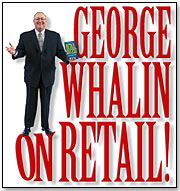The six weeks after Christmas are a bargain-hunter´s dream season. Smart retailers who plan for this event are cashing in, turning what was once the retail calendar’s dead zone into one of the most important sales periods of the year.
"There was a time that January was bad and you had to give away your existing inventory," said Howard Davidowitz, chairman of the New York retail consulting firm Davidowitz & Associates. "January used to be terrible and all markdowns. The point is to plan for it. There are a lot of people in the stores and they´re not just returning things; they are looking for deals. Post-Christmas business has become huge."
 According to the National Retail Federation, total sales in January of 2002 amounted to $6.3 billion.
According to the National Retail Federation, total sales in January of 2002 amounted to $6.3 billion.
"The real bargain hunters are going to be out because they know that´s when the best deals are," said Davidowitz. "Take greeting cards. Do you know how many people buy Christmas cards in the time after Christmas? Tons."
The popularity of gift certificates as holiday presents has also improved January sales. Marketed as a way to allow the recipient to choose their own gift, these certificates usually come back to the retailer in the weeks following the holiday season.
"Forty-five percent of consumers planned to buy a gift card in 2002," said Ellen Tolley of the NRF. "You might sell $10,000 worth of gift cards at Christmas, but that $10,000 won´t go on your books until it is redeemed for merchandise."
A continuing trend in post-Christmas sales is the flood of returned merchandise. Tolley believes that, instead of viewing returns as lost revenue, retailers should see it as an opportunity to generate new sales.
"Ten percent of holiday purchases are made after Christmas," Tolley pointed out. "When people return things, they usually buy something else. Returns are thought to be this nasty thing, but it can be a great way to get people back in your store."
 That´s something George Whalin, president and CEO of Retail Management Consultants, urges his clients to take advantage of.
That´s something George Whalin, president and CEO of Retail Management Consultants, urges his clients to take advantage of.
"Any retailer that is any good sells more products than they take back," he said. "They won´t, though, if their people are inattentive and frazzled and aren´t ´suggestive selling´ to customers. It´s about not letting your guard down and doing things that suggest you are ready for business."
Whalin admits that some independent retailers tend to relax following the Christmas rush, but that decision is costly, he believes. Instead, he suggests aggressively stocking and promoting discount merchandise.
"Smart retailers are bringing in discount merchandise that they can put on special," he said. "These are lower priced items with decent margins."
A strong marketing program using an email or postcard campaign targeted to repeat customers backs up this strategy. It´s an approach Davidowitz endorses for his clients as well.
"Our clients roll in merchandise they can mark down and promote like fiends," he said. "In the consumer´s mind, when do you get the best deals? After Christmas. The consumer is not going to buy any regularly priced merchandise, but if you bring in discount merchandise you can mark down at 50 or 70 percent off, they will buy."
Whalin suggests going a step further. "The issue today is, what are you doing to create a bond with a customer? If you are an independent retailer, you have to be doing that," Whalin said. "You could have a play date or hold some other event to get your customers in your store [after Christmas]."
What’s the recurring theme here? Today´s consumer knows when retailers are needy, and they expect to get something in return for shoring up your bottom line.
"Consumers have become very savvy," said Whalin. "If it´s a piece of merchandise they don´t need to have for a gift, they don´t mind waiting until after [the holidays]."

